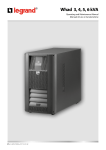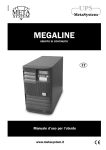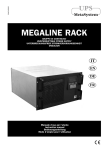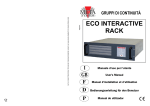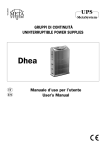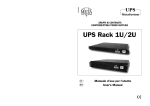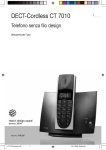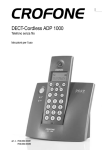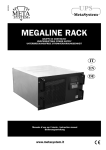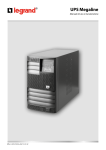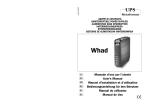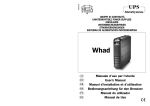Download V81575A Ist.Uso Whad6000 IT EN:V81575A Ist.Uso Whad6000
Transcript
V81575A UPS WHAD 3000 - 4000 - 5000 - 6000 GRUPPO DI CONTINUITA’ UNINTERRUPTIBLE POWER SUPPLY IT EN Manuale d’uso per l’utente User manual www.metasystem.it IT Dichiarazione Direttive del consiglio applicate: Standard al quale si dichiara la conformità: Costruttore: Indirizzo: Tipo di apparecchiatura: Modelli: Anno di apposizione del marchio: di Conformità 73/23/CEE modificata con le direttive 93/68/CEE 89/336/CEE modificata con le direttive 92/31/CEE, 93/68/CEE EN 62040-1-1, EN 50091-2, EN 62040-3 MetaSystem S.p.A. via Majakovskij, 10/b Reggio Emilia, Italia Gruppo di Continuità WHAD 3000 WHAD 4000 WHAD 5000 WHAD 6000 2007 L’apparecchiatura è stata provata nella configurazione tipica di installazione e con periferiche conformi alle direttive sopra elencate. Io sottoscritto dichiaro che l’apparato sopra definito soddisfa i requisiti delle Direttive sopra specificate. Reggio Emilia, 07/05/07 Ing. Cesare Lasagni Direttore Tecnico Le informazioni contenute nel presente manuale sono puramente indicative e, con l’obbiettivo di migliorare il prodotto, possono essere soggette a variazioni senza preavviso. 3 Indice Indice 1 - Introduzione 5 5 Avvertenze 2 - Funzionamento Principio di Funzionamento Funzionamento a rete Funzionamento a batteria Funzionamento a By-pass Segnalazioni ottiche e acustiche 3 - Installazione Predisposizione all’installazione Collocazione del Gruppo di Continuità Pannello Frontale Procedura d’installazione Guida all’uso del software autodiagnostico Accensione 4 - Caratteristiche Tecniche Specifiche costruttive Specifiche ambientali Caratteristiche elettriche d’ingresso Forma d’onda d’uscita Caratteristiche elettriche di uscita in funzionamento a rete Caratteristiche elettriche di uscita in funzionamento a batteria Funzionamento a batteria Caratteristiche del By-pass Normative di riferimento 5 - Soluzione ai problemi 6 6 6 6 6 7 8 8 8 9 9 12 12 13 13 13 14 14 14 15 15 15 15 17 4 Introduzione Vi ringraziamo per l’acquisto di un prodotto MetaSystem. Obiettivo primario della nostra Azienda è di fornire sempre prodotti all’avanguardia, frutto della ricerca e dell’applicazione delle tecnologie più innovative. Le nostre apparecchiature sono coperte da numerosi brevetti internazionali, rappresentativi del carattere di esclusività e continuo miglioramento dell’azienda MetaSystem. I gruppi di continuità MetaSystem sono stati studiati per proteggere le apparecchiature elettroniche dai problemi sulla rete elettrica, quali interruzioni, fluttuazioni e disturbi. In particolare il prodotto da Voi acquistato prevede l’esclusivo “Algoritmo di calcolo State of charge” per ottenere le migliori prestazioni di autonomia dell’UPS. La conformità del nostro prodotto agli standard internazionali è ulteriore garanzia di qualità dei nostri prodotti. Vi consigliamo di leggere attentamente il presente manuale e conservarlo per successive consultazioni Avvertenze • Non collegare carichi superiori ai limiti indicati nella targhetta di identificazione e nella documentazione a corredo • Non smontare l’apparecchiatura. L’accesso all’interno del gruppo di continuità è riservato a personale tecnico autorizzato. • Non disconnettere la connessione alla tensione di rete con gruppo di continuità funzionante, questa operazione elimina la protezione di terra per il gruppo di continuità e per i carichi ad esso collegati. • Non introdurre cacciaviti o altri oggetti nei fori di aerazione o nella ventola. • Installare l’apparecchiatura secondo quanto descritto nel presente manuale e rispettando i limiti previsti. • Non versare liquidi sul gruppo di continuità. • Utilizzare l’apparecchiatura esclusivamente per gli scopi indicati nel presente manuale. • Il costruttore declina ogni responsabilità per danni causati dall’inosservanza di quanto indicato nel presente manuale. Le informazioni contenute nel presente manuale sono puramente indicative e, con l’obbiettivo di migliorare il prodotto, possono essere soggette a variazioni senza preavviso. 5 2 - Funzionamento 2. Funzionamento Principio di funzionamento Il gruppo di continuità segnala all’operatore lo stato di funzionamento mediante segnalazioni ottiche e acustiche: - indicatore di stato 2 Pag. 9 - segnalatore acustico (interno al gruppo di continuità) La combinazione di queste segnalazioni rende rapida e intuitiva l’individuazione dello stato di funzionamento e di eventuali problemi alla rete di alimentazione. Sono possibili tre principali modi di funzionamento - Funzionamento a rete - Funzionamento a batteria - Funzionamento in By-pass Funzionamento a rete E’ la condizione di normale funzionamento: - la tensione di rete viene convertita dal regolatore del fattore di potenza (PFC) in tensione continua - l’inverter ricostruisce la tensione sinusoidale dalla tensione continua - il filtro di uscita effettua una ulteriore “pulizia” della tensione di uscita - le batterie vengono ricaricate Funzionamento a batteria Il gruppo di continuità in assenza della tensione di rete, commuta automaticamente nel modo di funzionamento a batteria. - la tensione delle batterie viene elevata dal circuito “survoltore” - l’inverter ricostruisce la tensione sinusoidale dalla tensione continua - il filtro di uscita garantisce la pulizia della tensione verso il carico Funzionamento a By-pass Il circuito di By-pass esclude il gruppo di continuità e collega direttamente l’uscita con l’ingresso. La commutazione avviene in modo sincronizzato al fine di garantire sempre la corretta tensione di uscita, evitando interruzioni o sovratensioni. L’intervento del circuito di By-pass è personalizzabile attraverso un menu dedicato (Config. UPS, By-pass) e prevede numerose opzioni (automatico, disabilitato, By-pass in attesa carico, etc..) in modo da rispondere alle specifiche esigenze dell’applicazione. 6 2 - Funzionamento Segnalazioni ottiche e acustiche INDICATORE DI STATO SEGNALATORE ACUSTICO Verde --- Verde --- UPS a Rete IN xxxV/x.xkW UPS a Rete Rete non sincronizzata xx.xHz Intermittente rapido Giallo Giallo Intermittente breve (ogni 20sec) Intermittente rapido DESCRIZIONE Funzionamento normale con rete presente e carico entro i limiti Il gruppo di continuità segnala che la frequenza della tensione di uscita non è sincronizzata con la tensione di ingresso. La causa può essere: - PLL disabilitato - Frequenza della tensione di ingresso al di fuori dei limiti previsti dal UPS UPS a Batteria RETE ASSENTE Funzionamento a batteria UPS a By-pass Funzionamento in By-pass --- Intermittente rapido Rosso MESSAGGI A DISPLAY Modulo guasto ATTENZIONE! SI CONSIGLIA DI SPEGNERE IL GRUPPO DI CONTINUITA’ E CONTATTARE IL CENTRO ASSISTENZA Intermittente breve e rapido Sovraccarico ATTENZIONE! SI CONSIGLIA DI SCOLLEGARE ALCUNE UTENZE FINO A RIPORTARE L’ASSORBIMENTO DEL CARICO ENTRO I LIMITI PREVISTI Rosso UPS in errore o è stato rilevato un guasto ATTENZIONE! SI CONSIGLIA DI SPEGNERE IL GRUPPO DI CONTINUITA’ E CONTATTARE IL CENTRO ASSISTENZA Continuo Rosso --Superato il 90% del carico MAX 1 ogni 10 sec. Rosso Intermittente alternato breve, lungo Rosso Intermittente breve con pausa Intermittente alternato breve, lungo RISERVA AUTONOMIA! Riserva di autonomia. In funzionamento a batteria Errato collegamento a batteria Neutro FUORI RIDONDANZA! L’assorbimento del carico è maggiore della ridondanza impostata. In caso di guasto non è garantita la ridondanza delle schede di potenza --- 7 3 - Installazione 3. Installazione Predisposizione all’installazione Verificare che l’imballo sia integro e che il prodotto non abbia subito danni durante il trasporto. In caso di problemi contattare il vettore. Verificare il contenuto della confezione: • Nr.1 gruppo di continuità • Nr.1 busta contenente accessori e set di viti per la corretta installazione del gruppo. • Manuale dell’utente • Garanzia internazionale Si consiglia di conservare l’imballo originale per eventuale riutilizzo o per rispedire il prodotto in caso di guasto. Collocazione del Gruppo di continuità Individuare una superficie piana e solida per il posizionamento del gruppo di continuità. Attenersi alle seguenti condizioni di installazione (Fig. 1): - il gruppo di continuità deve essere posizionato in ambienti chiusi: non è progettato per un uso all’esterno. - Rispettare le condizioni ambientali riportate nel presente manuale. - Evitare ambienti eccessivamente polverosi, umidi e sottoposti a irraggiamento diretto. - Evitare ambienti con liquidi infiammabili e/o sostanze corrosive. - Garantire l’aerazione posizionando l’apparecchiatura almeno 20 cm distante da pareti - Non coprire le zone di aerazione anteriori, posteriori e laterali. min 20cm min 20cm min 20cm Fig.1 Collocamento gruppo di continuità 8 3 - Installazione Pannello frontale 1 2 Fig. 2 Pannello anteriore 1 PULSANTE DI ACCENSIONE E SPEGNIMENTO 2 INDICATORE STATO DI FUNZIONAMENTO (verde/giallo/rosso) Procedura d’installazione 8 Connessioni elettriche 7 6 3 Connettore Ingresso/Uscita 4 Spina Ingresso/Uscita 5 6 7 8 Fusibile d’Ingresso Presa per Interfaccia seriale RS232 (9 P femm) Presa a segnali Logici ( 9 P maschio) Interfaccia SNMP 4 5 3 Fig. 3 Connessioni Elettriche 9 3 - Installazione UPS Whad 3000 - 4000 1. Cablare il connettore di Ingresso-Uscita in dotazione come indicato in figura 3, utilizzando un cavo inguainato con conduttori interni aventi sezione di almeno 2,5 mm2. 2. Inserire il connettore nel coperchio in plastica fissandolo con le apposite viti, quindi assicurare i cavi al coperchio tramite il fermacavo (vedi fig. 4). 3. Rimuovere la copertura della spina [4] togliendo la vite di fissaggio. 4. Collegare il connettore di Ingresso-Uscita alla spina [4] presente sul retro dell’UPS, fissandolo al telaio con le apposite viti (vedi fig. 3). 5. Collegare i carichi alla presa di uscita, verificando che gli interruttori dei vari utilizzatori siano spenti. 6. Collegare la spina di alimentazione ad una presa di corrente adeguata alla tensione e alla corrente richieste. Fig. 4 Coperchio morsettiera AVVERTENZA i L’UPS é dotato di un circuito di protezione contro un eventuale errore di collegamento, segnalato all’accensione del segnalatore visivo di colore rosso acceso fisso e dal suono continuo del buzzer interno. Nel caso si verificasse questa segnalazione subito dopo l’accensione dell’UPS, spegnere l’apparecchiatura e disconnettere immediatamente la spina di alimentazione. Precauzioni per l’installazione • • • • i Si consiglia di far eseguire gli allacciamenti elettrici da personale specializzato Non modificare i cablaggi elettrici forniti a corredo Assicurarsi che la presa di rete sia fornita di un buon collegamento di terra La connessione alla rete o il sezionatore di rete devono essere in prossimità del gruppo di continuità ed essere facilmente accessibili ATTENZIONE (per i modelli 3000/4000) Poichè le correnti di dispersione verso terra di tutti i carichi si sommano nel conduttore di protezione (filo di terra) dell’UPS, per motivi di sicurezza, come da norma EN 50091-1-1, occorre assicurarsi che la somma di queste correnti non superi il valore di 2.7 mA. Fig. 5 Morsettiera 10 3 - Installazione UPS Whad 5000 - 6000 1. Cablare il connettore di Ingresso-Uscita in dotazione come indicato in figure 4-5, utilizzando un cavo inguainato con conduttori interni aventi sezione di almeno 4 mm2. Collegare i carichi verificando che gli interruttori dei vari utilizzatori siano spenti. 2. Inserire il connettore nel coperchio in plastica fissandolo con le apposite viti, quindi assicurare i cavi al coperchio tramite il fermacavo (vedi fig. 6). 3. Rimuovere la copertura della spina [4] togliendo le viti di fissaggio. 4. Inserire il connettore di Ingresso-Uscita [3] nella spina [4] presente sul retro dell’UPS, assicurando il collegamento inserendo i quattro fissaggi di colore arancione negli appositi spazi presenti nella spina [4] 5. Fissare il coperchio in plastica al telaio con le apposite viti (vedi fig. 3). ! Fig. 6 Coperchio morsettiera ATTENZIONE I gruppi UPS Whad 5000 - 6000 non presentano il circuito di Back Feed Protection 1. L’installazione dei gruppi UPS Whad 5000 - 6000 dovrà essere solamente di tipo fisso con un sezionatore bipolare a monte. Non è ammesso il collegamento del gruppo alla rete mediante spina. 2. Si dovrà apporre un etichetta di avvertimento posta su tutti i sezionatori della potenza di rete installati lontanto dall’area dell’UPS allo scopo di richiamare il personale di assistenza sul fatto che il circuito è collegato a un UPS. L’etichetta deve riportare il testo seguente o equivalente: ISOLARE IL SISTEMA DI CONTINUITA’ (UPS) PRIMA DI OPERARE SU QUESTO CIRCUITO. AVVERTENZA ! L’UPS é dotato di un circuito di protezione contro un eventuale errore di collegamento, segnalato all’accensione del segnalatore visivo di colore rosso acceso fisso e dal suono continuo del buzzer interno. Nel caso si verificasse questa segnalazione subito dopo l’accensione dell’UPS, spegnere l’apparecchiatura e disconnettere immediatamente la spina di alimentazione. Precauzioni per l’installazione • Si consiglia di far eseguire gli allacciamenti elettrici da personale specializzato • Assicurarsi che la rete sia fornita di un buon collegamento di terra • La connessione al sezionatore di rete deve essere in prossimità del gruppo di continuità ed essere facilmente accessibile Fig. 7 Morsettiera 11 3 - Installazione Guida all’uso del Software autodiagnostico Connessione L’UPS è dotato di interfaccia standard RS232, grazie alla quale è possibile accedere, tramite un elaboratore, ad una serie di dati relativi al funzionamento e alla storia dell’UPS. La funzione è utilizzabile tramite il programma di interfacciamento per ambiente WINDOWS disponibile gratuitamente sul sito www.metasystem.it, connettendo una porta seriale del PC alla presa di interfacciamento [6] presente sul retro dell’UPS, tramite un cavo RS232. Accensione 1) Accendere il gruppo di continuità con l’apposito pulsante [1]; inizialmente l’UPS alimenterà l’uscita direttamente dalla rete tramite il by-pass (segnalazione del indicatore di stato di colore giallo [2]) per poi commutare a inverter dopo alcuni secondi ed entrare nel modo normale di funzionamento (indicatore di stato verde [2]). 2) Accendere i carichi e verificare che, dopo l’eventuale intervento del by-pass, si abbia il ritorno al funzionamento normale; a questo punto è acceso l’indicatore di stato di colore verde [2]. Nel caso i carichi collegati risultino eccessivi, rimarrà inserito il by-pass e lampeggerà l’indicatore di stato di colore rosso [2] in modo rapido. 3) Qualche istante dopo l’accensione, il gruppo di continuità esegue automaticamente il test delle batterie, per verificarne il corretto funzionamento (vedi paragrafo “Test Batterie”). 12 4 - Caratteristiche tecniche 4. Caratteristiche Tecniche Specifiche Costruttive Pesi (Kg.) Dimensioni (LxHxP) Tecnologia Interfaccia computer Protezioni By-pass sincronizzato WHAD 3000 WHAD 4000 WHAD 5000 WHAD 6000 55 55 65 65 270 x 475 x 570 mm PWM ad alta frequenza sia per lo stadio di ingresso che per quello di uscita. Logica di controllo a microprocessore A livelli logici, per interfacciamento con kit opzionali. Uscita su connettore a vaschetta 9 poli maschio, isolato SELV. Seriale RS232 standard per interfacciamento con personal computer tramite software di shutdown autodiagnostico. Uscita su connettore a vaschetta 9 poli femmina isolato SELV. Interfaccia SNMP. Elettroniche contro sovraccarichi, cortocircuito ed eccessiva scarica delle batterie. Blocco del funzionamento per fine autonomia. Limitatore di spunto all’accensione. Sensore di corretto collegamento del neutro. Backfeed protection (isolamento elettrico di sicurezza della spina d’ingresso durante il funzionamento a batteria). Contatto EPO per collegamento “fungo VVF” Statico automatico e manuale (optional). Intervento per sovraccarico o anomalia di funzionamento. Specifiche Ambientali Altitudine max immagazzinamento 10.000 metri Gamma temperature da -20° C a +50° C immagazzinam. Gamma temperature da 0° C a +40° C funzionamento Gamma umidità relativa funzion. 20-80% non condensante Grado di protezione (IEC529) IP 21 Rumore acustico ad 1mt. (<) 40dB A 13 4 - Caratteristiche tecniche Caratteristiche Elettriche d’ Ingresso WHAD 4000 WHAD 3000 WHAD 5000 Tensioni nominali d’ingresso 230 V Gamma tensione ingresso Frequenza nom.ingresso Corrente massima d’ingresso WHAD 6000 da 184V a 264V con carico nom. - da 100V a 264V al 50% del carico nom. 50 Hz o 60 Hz +2% (autosensing e/o selezionabile dall’utente) 13A rms Distorsione corrente d’ingresso Fattore di potenza d’ingresso 18A rms 22A rms THD 27A rms < 3% > 0,99 dal 20% del carico nominale Corrente di spunto 100% della corrente nominale Numero fasi d’ingresso Monofase Forma d’Onda d’Uscita In funzionamento a rete In funzionamento a batteria Tipologia di funzionamento Sinusoidale Sinusoidale Gruppo di continuità di tipo no-break, on-line, doppia conversione con neutro passante Caratteristiche Elettriche di Uscita in Funzionamento a Rete Tensione nominale d’uscita Frequenza nominale d’uscita Corrente max d’uscita su carico lineare fattore di potenza 0,7 230 V ± 1% 50 Hz / 60Hz sincronizzata (autosensing e/o selezionabile dall’utente) 13A rms 18A rms Fattore di cresta sulla corrente d’uscita Potenza nominale d’uscita Potenza attiva d’uscita sucarico lineare o non lineare P.F. 0,7 22A rms 27A rms 3,5 3000VA 4000VA 5000VA 6000VA 2100W 2800W 3500W 4200W Capacità di sovraccarico 150% per 30 secondi senza intervento del By-pass N.ro delle fasi d’uscita Monofase 14 4 - Caratteristiche tecniche Caratteristiche Elettriche di Uscita in Funzionamento a Batteria WHAD 4000 WHAD 3000 Tensione nominale d’uscita Frequenza nominale d’uscita Corrente max d’uscita su carico lineare fattore di potenza 0,7 230 V ± 1% 50 Hz / 60Hz ± 1% (autosensing e/o selezionabile dall’utente) 13A rms 18A rms 22A rms 27A rms 3000VA 4000VA 5000VA 6000VA 2100W 2800W 3500W 4200W Potenza nominale d’uscita Potenza attiva d’uscita sucarico lineare o non lineare P.F. 0,7 N.ro delle fasi d’uscita ! WHAD 6000 WHAD 5000 Monofase ATTENZIONE: Pericolo di esplosione se la batteria è sostituita con un’altra di tipo scorretto. Eliminare le batterie usate seguendo le istruzioni e precauzioni di smaltimento indicate sulle stesse. Funzionamento a Batteria Autonomia indicativa in minuti con batterie cariche Carico applicato in percentuale 80% 100% 80% 100% 80% 100% 80% 100% UPS Standard 15 10 11 8 15 10 11 8 Tempo di ricarica fino al 90% della carica totale Dati tecnici e quantità delle batterie Tempo medio di vita delle batterie 8 ore a seconda del livello di scarica raggiunto n. 12 batterie piombo-acido sigillate senza manutenzione 12V 7,2Ah connesse in serie. n. 16 batterie piombo-acido sigillate senza manutenzione 12V 7,2Ah connesse in serie. 3-6 anni a seconda dell’utilizzo e della temperatura di esercizio. Attenzione! Le batterie contenute nell’UPS, sono soggette ad una diminuzione di capacità in funzione del tempo di vita (caratteristica propria della batterie al piombo dichiarata dal costruttore del manuale tecnico). Ad esempio, la diminuzione di capacità di una batteria con 4 anni di vita può arrivare fino al 40% con conseguente calo proporzionale dei tempi di autonomia dell’UPS in funzionamento a batteria. Caratteristiche del By-pass Tipo di bypass Statico ed elettromeccanico Tempo di commutazione nullo 15 4 - Caratteristiche tecniche Normative di riferimento WHAD 4000 WHAD 3000 Sicurezza: progettato per soddisfare la norma Compatibilità elettromagnetica: •immunità •emissioni Prestazioni caratteristiche WHAD 5000 WHAD 6000 Rispondente alla normativa EN 62040-1-1 Rispondente alla normativa EN 50091-2 Rispondente alla normativa EN 50091-2 (classe A) (classe B) Rispondente alla normativa EN 62040-3 Dati e caratteristiche tecniche possono essere variati da MetaSystem senza preavviso MANUTENZIONE PERIODICA Pulizia Prima di effettuare le operazioni di pulizia si raccomanda di: - Spegnere le apparecchiature collegate al gruppo di continuità - Scollegare le apparecchiature dal gruppo di continuità - Scollegare la rete dal gruppo di continuità Pulizia esterna - Pulire utilizzando un panno morbido e asciutto Pulizia delle aperture di raffreddamento - Eseguire periodicamente la pulizia delle aperture di raffreddamento, aspirando o utilizzando un pennello morbido 16 5 - Soluzione ai problemi 5. Soluzione ai problemi Problemi Soluzioni All’accensione l’UPS fa suonare il cicalino e lampeggiare il segnalatore visivo rosso con intermittenza di tipo alternato breve-lungo, quindi si spegne dopo 15 secondi. È errato il collegamento del conduttore di neutro: girare la spina di alimentazione, oppure invertire il senso di collegamento dei cavi di neutro e fase di ingresso, oppure escludere sensore di neutro. L’UPS funziona ma ogni 12 secondi emette un breve segnale acustico ed é sempre acceso il segnalatore visivo giallo BATTERY. - Assicurarsi della presenza di tensione nella presa di rete. - Controllare il perfetto inserimento del cavo di alimentazione del gruppo di continuità sia nella presa di rete che nel connettore del gruppo stesso. - Verificare lo stato del fusibile che si trova di fianco al connettore di ingresso/uscita sotto il coperchio in plastica (vedi figura 1 o 4). L’UPS funziona ma emette un segnale acustico intermittente e lampeggia il segnalatore visivo rosso + giallo By-pass. È presente un sovraccarico dell’uscita dell’UPS. Ridurre il numero di apparecchiature collegate in modo che il carico non superi la massima potenza erogabile dal gruppo di continuità. In alternativa, se non si è già in configurazione massima, è possibile richiedere al Centro Assistenza Tecnica di aumentare la potenza del gruppo aggiungendo, all’interno dell’UPS, uno o più moduli con le relative batterie. L’UPS emette un segnale acustico costante ed é acceso il segnalatore visivo giallo lampeggiante per circa 15 secondi, dopo di che il gruppo si spegne. Il gruppo ha scaricato completamente le batterie, può ripartire solo se la linea d’ingresso è presente. Controllare gli interruttori magnetotermici o differenziali a monte del gruppo e il fusibile d’ingresso L’UPS funziona ma il segnalatore visivo verde La rete è fuori dai limiti consentiti come tensione MAINS lampeggia in modo rapido. e/o come frequenza, ma pur sempre utilizzabile dall’UPS. Non è però disponibile la funzione di By-pass. L’UPS emette un segnale acustico intermittente e il segnalatore visivo rosso lampeggia in modo rapido. È intervenuta la protezione termica. Spegnere il gruppo di continuità e attendere qualche minuto in modo che la temperatura interna dell’UPS si normalizzi. Verificare il corretto funzionamento delle ventole e che il relativo flusso d’aria non sia ostacolato (ad es. gruppo troppo vicino ad una parete). È avvenuto un guasto in qualche circuito interno. Contattare il centro di assistenza. Se il problema persiste contattare il centro assistenza MetaSystem al numero verde: Numero Verde 800-005088 17 EN Certification of Directives applied: We certify conformity to standards: Manufacturer: Address: Type of appliance: Models: Year of application: conformity 73/23/EEC modified with directives 93/68/EEC; 89/336/EEC modified with directives 92/31/EEC, 93/68/EEC EN 62040-1-1, EN 50091-2, EN 62040-3 MetaSystem S.p.A. via Majakovskij, 10/b Reggio Emilia, Italy Uninterruptible Power Supply WHAD 3000 WHAD 4000 WHAD 5000 WHAD 6000 2007 The appliance was tested in the typical configuration for its installation and with peripherals in compliance with the above Directives. The undersigned certifies that the above appliance satisfies the requirements of the specified Directives. Reggio Emilia, 07/05/07 Ing. Cesare Lasagni Technical Manager All the information contained in this manual is provided as a guide and is subject to change without notice for product upgrading. 18 Index Index 1 - Introduction 20 20 Important information 2 - Operation Operating principle Mains operation Battery operation By-pass operation Visual and acoustic warning signals 3 - Installation Prior to installation Where to install your UPS Front panel Installation procedure Guide to using the diagnostics software Switching on 4 - Specifications Construction specifications Environmental specifications Electrical input specifications Output waveform Electrical output specifications when running on mains power Electrical output specifications when running on battery power Battery operation By-pass specifications Reference standards 5 - Troubleshooting 21 21 21 21 21 22 23 23 23 24 24 27 27 28 28 28 29 29 29 30 31 31 31 33 19 Introduction Thank you for choosing to purchase a MetaSystem product. Our company’s main objective is to supply innovative products that are the outcome of our ongoing research and application of cutting-edge technology. Our products are covered by several international patents, emblematic of MetaSystem’s quest for exclusivity and ongoing improvement. MetaSystem uninterruptible power supplies are designed to protect electronic equipment from problems that may be encountered with your mains electricity supply, such as power cuts, surges and interference. In particular, the product you have purchased is enhanced with our exclusive “State of Charge Algorithm” which makes it possible for your UPS to achieve the best possible performance in terms of autonomy. Our products comply with international standards: an additional guarantee of the quality of our products. We recommend you read this manual carefully and keep it for future reference. Important information • Do not connect loads in excess of the limit stipulated on the product’s label and in the relative documents provided. • Do not dismantle the UPS. Only authorised technical personnel are allowed access to the internal parts of the UPS. • Never disconnect the UPS from the mains power supply when it is running: this would cut off the earth protection of both the UPS and of the loads connected to it. • Do not insert screwdrivers or other items inside the ventilation holes or into the fan. • The UPS must be installed according to the instructions in this manual and in compliance with the set limits. • Take care that no liquids come into contact with your UPS. • This product should only be employed for the designated uses described in this manual. • The manufacturer is not liable for any damage or injury caused by failure to comply with the instructions in this manual. All the information contained in this manual is provided as a guide and is subject to change without notice for product upgrading. 20 2 - Operation 2. Operation Operating procedure The UPS keeps the operator informed regarding its operating status using visual and acoustic signals: - status indicator 2 on page 24 - acoustic signal (located inside the UPS) The combination of these signals enables rapid and intuitive understanding of its operating status and recognition of any problems in the power supply. There are three main operating modes - Mains operation - Battery operation - By-pass operation Mains operation This is considered the normal operating condition: - mains voltage is converted by the power factor corrector (PFC) into continuous current - the inverter reconstructs the sinusoidal voltage from the continuous current - the output filter provides extra “cleaning” of the output voltage - the batteries are recharged Battery operation When there is a mains power failure, the UPS automatically switches over to battery mode. - the voltage of the batteries is increased by the “booster” circuit - the inverter reconstructs the sinusoidal voltage from the continuous current - the output filter ensures the voltage supplied to the load is clean By-pass operation The by-pass circuit excludes the UPS and connects the output directly to the input. The switchover takes place in a synchronised manner in order to ensure the correct output voltage is always guaranteed, preventing the risk of a break in power or excess voltage. The intervention of the by-pass circuit can be customised by means of a dedicated menu (Config. UPS, By-pass) which provides many options (automatic, disabled, by-pass in load waiting mode, etc.) in order to meet the specific demands of the application. 21 2 - Operation Visual and acoustic warning signals STATUS INDICATOR ACOUSTIC SIGNAL Green --- Green --- Fast flashing Yellow Yellow Short intermittent sound (every 20sec) Fast flashing DESCRIPTION UPS on Mains IN xxxV Normal operation with mains present and loads within the set limits UPS on Mains No sync mains xx.xHz The UPS is indicating that the frequency of the output voltage is not synchronised with the input voltage. The cause of this may be: - PLL disabled - Frequency of the input voltage is outside the set limits for the UPS UPS on Batteries MAINS ABSENT Battery operation UPS on Bypass By-pass operation --- Fast flashing Red MESSAGES DISPLAYED Module failure ATTENTION! WE RECOMMEND YOU SWITCH OFF THE UPS AND CONTACT YOUR SERVICE CENTRE Short and fast intermittent sound Overload ATTENTION! WE RECOMMEND REMOVING SOME OF THE APPLIANCES CONNECTED TO THE UPS SO THAT CONSUMPTION BY THE LOAD RETURNS BELOW SET LIMITS Red Red UPS error or failure ATTENTION! WE RECOMMEND YOU SWITCH OFF THE UPS AND CONTACT YOUR SERVICE CENTRE Continuous sound --Above 90% of MAX load 1 flash every 10 secs. Red Alternating short long flashing Red Short flashing with pause Alternating short, long intermittent sound RESERVE AUTONOMY! --OUT OF REDUNDANCY! 22 Autonomy reserve. During battery operation Incorrect battery connection Incorrect Neutral Consumption by the load is above the redundancy that has been set. Power board redundancy is not guaranteed in case of failure 3 - Installation 3. Installation Prior to installation Check the packaging has not been opened or damaged and that the product has not been damaged during transport. Please contact your shipping agent in case of doubt. Check the contents of the box: • Nr.1 UPS • Nr.1 connector for the input/output cable (single cabinet version includes multiple output socket and input cable) • Instructions manual We recommend you keep the equipment’s packaging materials as they can be useful should the need arise to send the product back for repairs. Where to install your UPS Make sure the place where you intend installing your UPS is level and sturdy. Please comply with the following requisites for installation (Fig. 1): - The UPS must be located in an enclosed environment: it was not designed to operate out of doors. - It is essential that you comply with the environmental conditions illustrated in this manual. - Avoid placing it in very dusty or damp areas or in direct sunlight. - Avoid places where there are inflammable liquids and/or corrosive substances. - Ventilation must be guaranteed by placing the UPS at least 20 cm away from any walls - Do not cover the ventilation outlets on the front, rear or sides of the UPS min 20cm min 20cm min 20cm Fig.1 Where to install the UPS 23 3 - Installation Front panel 1 2 Fig. 2 Front Panel 1 BUTTON TO SWITCH ON / SWITCH OFF 2 MULTICOLOUR OPERATING STATUS INDICATOR LIGHT (GREEN / YELLOW / RED) Installation procedure 8 Electrical connections 7 6 Single Cabinet (fig. 2): 3 4 5 6 7 8 Input/Output connector Input/Output plug Input fuse RS232 serial interface outlet (9-pin female) Logic signals outlet (9-pin male) SNMP Interface 4 5 3 To the loads To the mains electricity supply Fig. 3 Electrical Connections 24 3 - Installation Single cabinet INPUT-OUTPUT h h CONNECTOR Assembly 1. Wire up the Input-Output connector supplied as shown in figure 4, using insulated cable with wires whose section is at least 2.5 mm2. 2. Insert the connector into the plastic housing and secure it using the screws supplied. Secure the wires to the housing using the cable grip (see fig. 4). 3. Take the cover off the plug [4] by removing its screws. 4. Put the Input-Output connector into the plug [4] located on the rear of the UPS, and secure to its case using the screws supplied (see fig. 3). 5. Check that the on/off switches of all the appliances to be connected to the UPS are OFF and connect them to the output socket. 6. Insert the power supply plug into a power outlet that is adequate for the voltage and current required. i ° CONNECTOR Reference h notch h PLASTIC HOUSING h h CABLE GRIP Fig. 4 Connection terminals housing WARNING Your UPS is fitted with a circuit to protect it against the risk of incorrect connections. This eventuality will be indicated by means of its red warning light, lit without flashing, and the continuous sounding of its internal buzzer. Should you note this signal immediately after switching the UPS on, switch it off and remove the power supply plug immediately. Precautions for installation • • • • Electrical connections should only be done by trained personnel Do not modify the electric cables supplied Make sure that the mains outlet is connected securely to an earth circuit The mains outlet, or the circuit breaker, must be installed near the appliance and must be easily accessible ATTENTION i (for versions 3000/4000) Since current dispersion towards earth of all the loads merges in the UPS protection wire (earth wire), it is essential to check that the sum of these currents does not exceed 2.7 mA, according to standard EN 50091-1-1, for safety reasons. INPUT-OUTPUT CONNECTOR Side with insertion of wires Earth connection Yellow-green wire Brown wire Blue wire Yellow-green wire Blue wire Brown wire Input cable (to the mains electricity supply) Output cable (to load) Terminal n°1 PHASE OUTPUT Terminal n°2 NEUTRAL OUTPUT Terminal n°3 NEUTRAL OUTPUT Terminal n°4 PHASE OUTPUT Fig. 5 Terminals 25 3 - Installation Single cabinet UPS What 5000 - 6000 INPUT-OUTPUT CONNECTOR Assembly 1. Wire up the Input-Output connector supplied as shown in figure 6-7, using insulated cable with wires whose section is at least 4 mmq. Check that the on/off switches of all the appliances to be connected to the UPS are OFF. 2. Insert the connector into the plastic housing and secure it using the screws supplied. Secure the wires to the housing using the cable grip (see fig. 6). 3. Take the cover off the plug [4] by removing its screws. 4. Put the Input-Output connector [3] into the plug [4] located on the rear of the UPS, and secure to the plug using the orange flanges for secure. 5. Secure the plastic housing to the rear of the UPS the screws supplied (see fig. 3). Reference notch Plastic Housing Cable grip Fig. 6 Connection terminals housing WARNING ! UPS What 5000 - 6000 don’t have internal automatic back feed protection. 1. The WHAD series of UPS must be permanently connected. An appropriate and accessible disconnect device shall be incorporated in the fixed wiring. It's forbidden to connect the UPS to mains power using a traditional plug. 2. A warning label shall be fit on all primary power isolators installed remote from the UPS area in order to warn electrical maintenance personnel that the circuit feeds an UPS. The warning label shall carry the following wording or equivalent: ISOLATE UNINTERRUPTIBLE POWER SUPPLY (UPS) BEFORE WORKING ON THIS CIRCUIT ! WARNING Your UPS is fitted with a circuit to protect it against the risk of incorrect connections. This eventuality will be indicated by means of its red warning light, lit without flashing, and the continuous sounding of its internal buzzer. Should you note this signal immediately after switching the UPS on, switch it off and remove the power supply plug immediately. Precautions for installation • Electrical connections should only be done by trained personnel • Make sure that mains is connected securely to an earth circuit • The circuit breaker must be installed near the appliance and must be easily accessible INPUT-OUTPUT CONNECTOR Fig. 7 Terminals Side with insertion of wires Input cable (to the mains electricity supply) Output cable (to load) Terminal n°2: Neutral Output Terminal n°3: Earth Output Terminal n°4: Phase Output Terminal n°5: Neutral Input Terminal n°6: Earth Input Terminal n°7: Phase Input 26 3 - Installation Guide to using the diagnostics software Connection Your UPS is fitted with a standard RS232 interface, which can be used in conjunction with a computer in order to access data relating to the operation of the UPS and its log. This function must be used together with the interface programme for WINDOWS environments available from our website www.metasystem.it without charge. A RS232 cable is required to connect a serial port on your PC to the interface outlet [6] located on the rear of the UPS. Switching on 1) Switch the UPS on with the appropriate button (1). The UPS initially supplies the output directly with mains power using its bypass (signalled by the yellow Status Indicator) (2) and after a few seconds switches over to its inverter and enters its normal operation mode (the green Status Indicator [2] is on). 2) Switch the connected loads on and, after any bypass intervention, check that normal operation is resumed: at this point the green Status Indicator [2] is on. Should the connected loads be too large, the bypass will remain active and the red Status Indicator [2] will flash fastly. 3) A few moments after switching on, the UPS will automatically test its batteries to check if they are operating correctly (refer to the section on the ‘Battery Test’). 27 4 - Specifications 4. Specifications Construction specifications Weight (Kg.) WHAD 3000 WHAD 4000 WHAD 5000 WHAD 6000 55 55 65 65 Size (LxHxP) 270 x 475 x 570 mm Technology PWM high frequency both for input stage and output stage. Microprocessor control logic Computer Interface With logic levels, to interface with optional kits. Output with 9-pin male, SELV insulated connector. Standard serial RS232 for interfacing with personal computer using diagnostics software. Output with 9pin, female, SELV insulated, connector. Protection Electronic protection against overloads, short circuits and excessive battery discharge. Operation blocked at end of autonomy. Inrush limitation when switching on. Sensor for correct neutral connection. Back-feed protection (electrical insulation for the safety of the input plug when running in battery mode). EPO contact (emergency power off) Synchronised By-pass Automatic static and manual (optional). Intervenes in case of overload and operating anomaly. Environmental specifications Maximum altitude for storage Storage temperature range Operating temperature range Range of relative humidity for operating 10.000 metres from -20° C to +50° C from 0° C to +40° C 20-80% non condensing Grade of protection (IEC529) IP 21 Noise level at 1 metre (<) 40dB A 28 4 - Specifications Electrical input specifications WHAD 3000 WHAD 5000 WHAD 4000 Nominal input voltage Input voltage range Nominal input frequency Maximum input current WHAD 6000 230 V from 184V to 264V with nom. load – from 100V to 264V with 50% of nom. load 50 Hz or 60 Hz +/-2% (autosensing and/or as selected by operator) 13A rms 18A rms Distortion of input current Input power factor 22A rms THD 27A rms < 3% > 0,99 dal 20% of nominal load In-rush current 100% of nominal current Number of input phases Single phase Output waveform With mains operation Sine wave With battery operation Sine wave Type of operation No break, on line UPS with passing neutral and double conversion Electrical output specifications when running on mains power Nominal output voltage Nominal output frequency Output current with linear load and power factor 0,7 230 V ± 1% 50 Hz / 60Hz synchronised (autosensing and/or as selected by operator) 13A rms 18A rms Crest factor on output current 22A rms 27A rms 3,5 Nominal output power VA 3000VA 4000VA 5000VA 6000VA Active output power with linear or nonlinear load P.F. 0,7 2100W 2800W 3500W 4200W Overload capacity 150% for 30 seconds without By-pass intervention Number of output phases Single phase 29 4 - Specifications Electrical output specifications when running on battery power WHAD 3000 Nominal output voltage Output frequency WHAD 5000 WHAD 4000 WHAD 6000 230 V ± 1% 50 Hz / 60Hz ± 1% (autosensing and/or as selected by operator) Nominal output power VA Active output power with linear or nonlinear load P.F. 0,7 3000VA 4000VA 5000VA 6000VA 2100W 2800W 3500W 4200W Number of output phases ! Single phase ATTENTION: There is a danger of explosion should the batteries be replaced with the wrong type. Dispose of used batteries as per the instructions and precautions for their disposal on the battery label! 30 4 - Specification Battery operation WHAD 3000 WHAD 6000 WHAD 5000 WHAD 4000 Approximate autonomy in minutes with charged batteries Percentage of applied load 80% 100% 80% 100% 80% 100% 80% 100% Standard UPS 15 10 11 8 15 10 11 8 Recharge time up to 90% of total charge Specifications and quantity of batteries Average battery life 8 hours according to level of discharge n. 12 pcs 12V 7,2Ah, sealed, lead-acid, maintenance free batteries connected in series n. 16 pcs 12V 7,2Ah, sealed, lead-acid, maintenance free batteries connected in series 3-6 years according to use and working temperature Warning! The batteries in the UPS are subject to a reduction in capacity depending on their age (a feature of lead batteries declared by their manufacturer in the technical manual). For example, the reduction of capacity of a 4-year-old battery can be as much as 40%, resulting in a proportional reduction of UPS autonomy time when running on battery power. By-pass Specifications Type of by-pass Static and electromechanical Switchover time zero Reference Standards Safety: Designed to satisfy standard Electromagnetic compatibility: •immunity •emission Typical performance Conforms to standard EN 62040-1-1 Conforms to standard EN 50091-2 Conforms to standard EN 50091-2 (class A) (class B) Conforms to standard EN 62040-3 31 4 - Specifications MetaSystem reserves the right to vary data and specifications without notice ROUTINE MAINTENANCE Cleaning Before cleaning, it is essential to verify the following: - all appliances connected to the UPS have been switched off - all the appliances have been disconnected from the UPS - the UPS has been disconnected from the mains power supply Cleaning the cabinet - Clean with a soft dry cloth Cleaning the air vents - Clean the air vents regularly by vacuuming them or using a soft brush 32 5 - Troubleshooting Guide 5. Troubleshooting Problems Solutions When the UPS is switched on, the buzzer sounds and the red warning light makes alternating short-long flashes, then the UPS switches off after 15 seconds The connection of the neutral conductor is wrong: invert the power supply plug, or invert the connections of the neutral and phase input leads, or exclude the neutral sensor. The UPS works but a short beep is heard every 12 seconds and the yellow warning light is lit without flashing. The UPS works but it beeps intermittently and the red warning light and the yellow warning light are flashing. The UPS beeps continuously and the yellow warning light flashes for about 15 seconds, after which the UPS switches off - Check power is present at the mains outlet. - Check that the UPS power supply cable is correctly inserted in both the mains outlet and in the connector on the UPS itself. - Check the fuse located at the side of the input/output connector under the plastic housing (refer to fig.1 or 4) There is an overload on the UPS output. Reduce the quantity of appliances connected so that the load does not exceed the maximum power that the UPS can supply. Alternatively, if the UPS is not in its maximum configuration, you can ask your Service Centre to increase the power of your UPS by fitting extra power boards and relative batteries inside the UPS cabinet. The UPS has completely flattened its batteries; it can only start up again when the mains input line is present. Check the magneto-thermal or differential switches that precede the UPS and the input fuse The UPS works but the green warning light is The mains supply is out of the limits permitted for flashing quickly the voltage and/or frequency, but it can still be used by the UPS. However, the by-pass function is not operational The UPS beeps intermittently and the red warning light is flashing quickly. 33 The thermal protection has been tripped. Switch the UPS off and wait for a few minutes so that the internal temperature of the UPS can get back to normal. Check that the fans operate correctly and that the relative airflow is not obstructed (e.g. if the UPS is too close to a wall). There is a fault on one of the internal circuits. Contact your service centre. CENTRO ASSISTENZA TECNICA Numero Verde 800-005088 www.metasystem.it MetaSystem S.p.A. Via Galimberti,8 - 42100 Reggio Emilia Tel. +39 0522 364.111 Fax +39 0522 308.382




































